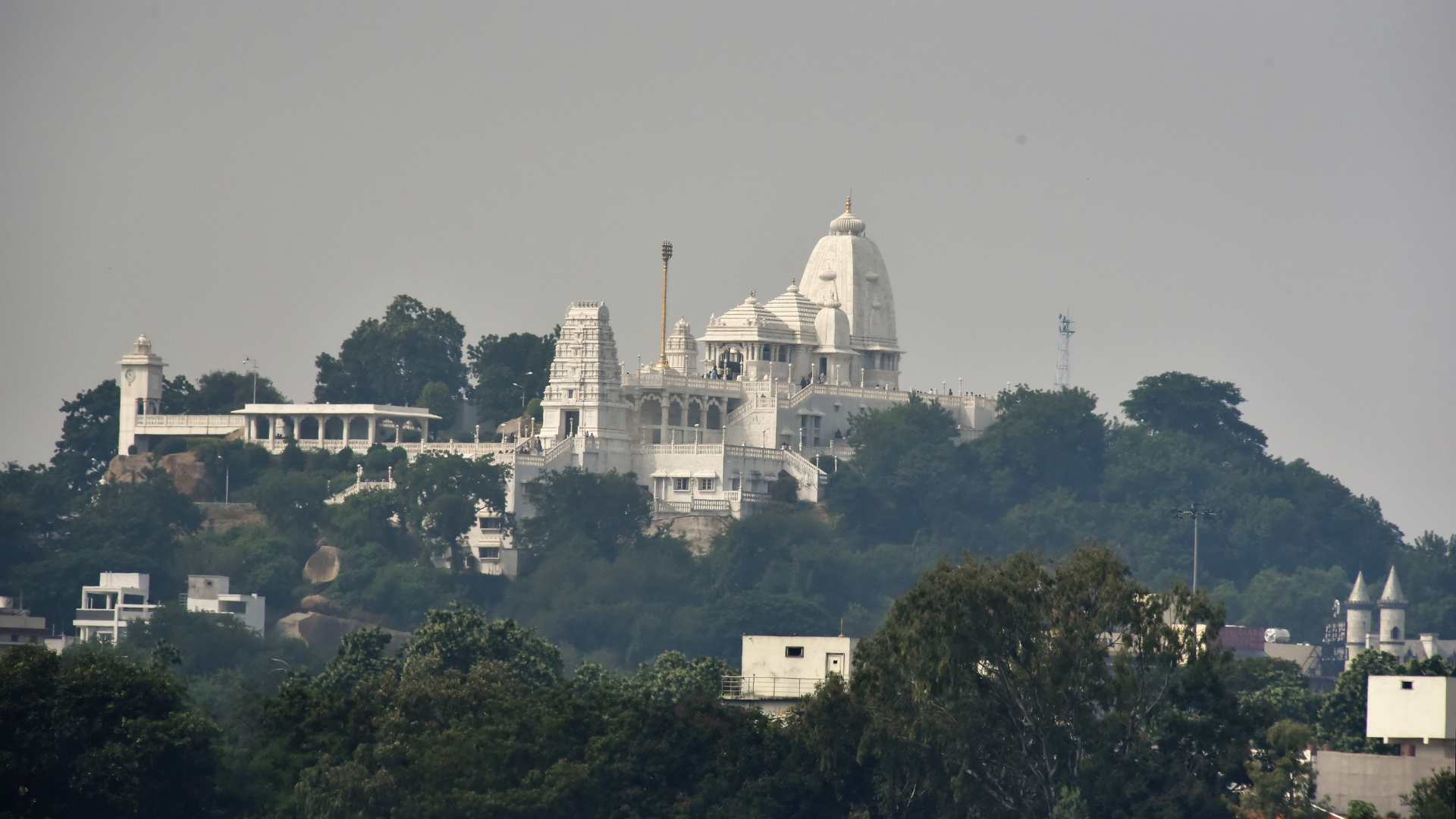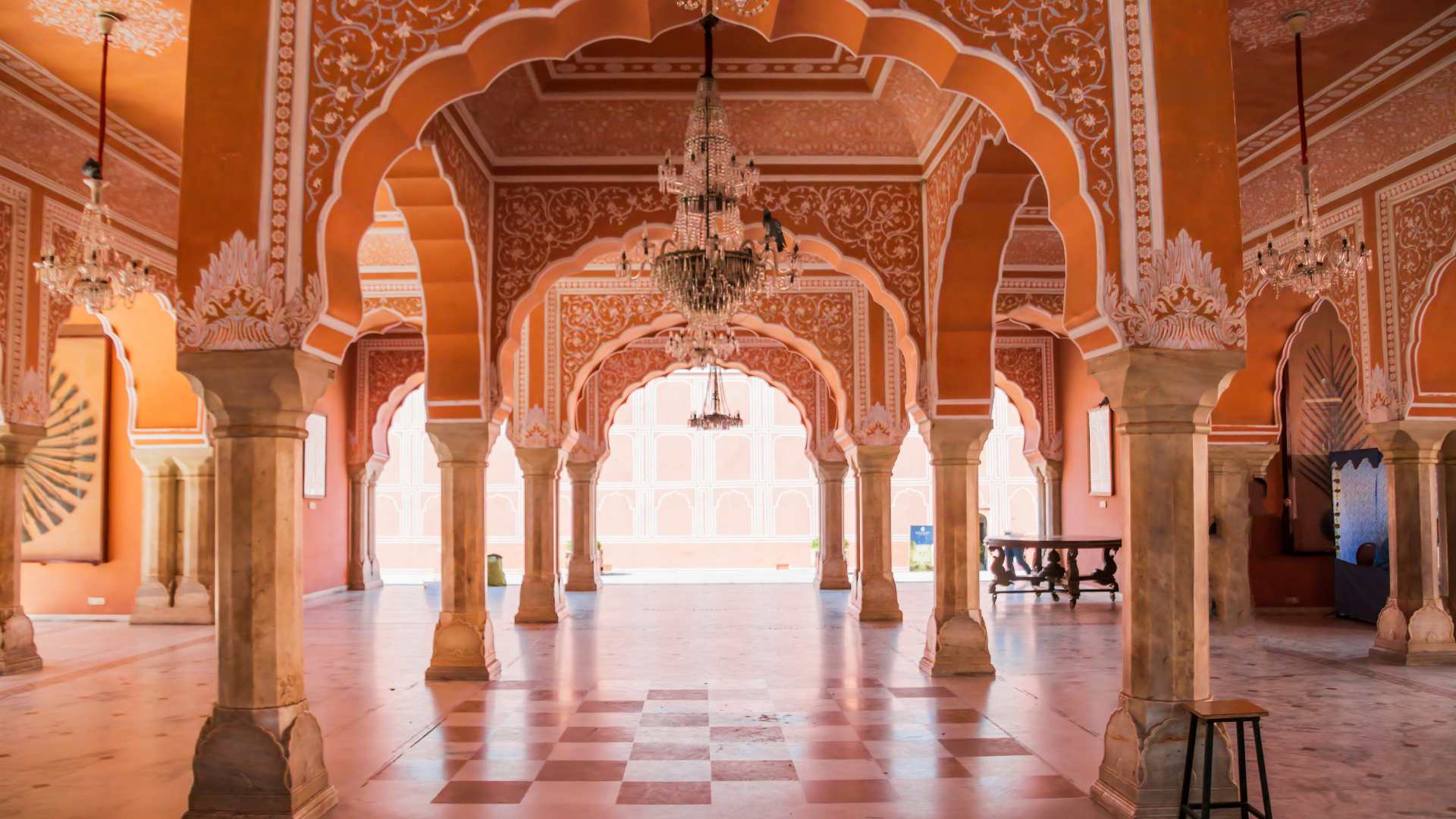Table of Contents
ToggleWhy is Govind Dev Ji Mandir one of the most cherished spiritual landmarks in Jaipur? What makes this temple, nestled within the City Palace complex, so special for devotees of Lord Krishna?
With a rich history dating back to the 16th century, Govind Dev Ji Mandir is not only a center of devotion but also a testament to Jaipur’s royal heritage.
Visitors are drawn to its serene environment, captivating rituals, and beautifully adorned deity, believed to closely resemble Lord Krishna’s earthly form.
Whether you’re visiting for darshan, attending an aarti, or exploring Jaipur’s cultural treasures, this temple offers a deeply spiritual and unforgettable experience.
What Are the Timings for Govind Dev Ji Mandir?
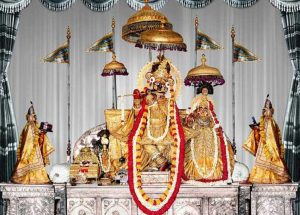
Image – Source
Govind Dev Ji Mandir is one of the most revered temples in Jaipur, attracting thousands of devotees every day. The temple operates on a strict schedule to accommodate various rituals, aartis, and darshan timings. The timings vary between the summer and winter seasons to ensure the comfort of both the devotees and temple priests.
During summer, the temple opens early at 4:30 AM, with the first darshan occurring during the Mangla Aarti. The temple closes at 12:00 PM in the afternoon and reopens at 5:45 PM, offering darshan until 9:30 PM.
In winter, the opening time shifts to 5:00 AM due to the colder climate, and darshan is available until 12:15 PM in the afternoon. Evening darshan resumes at 5:00 PM and continues until 8:45 PM.
Here is a summary of the darshan timings for convenience:
| Category | Details |
| Place | Govind Dev Ji Mandir, Jaipur |
| Entry Timing | Summer: 4:30 AM – 12:00 PM, 5:45 PM – 9:30 PM Winter: 5:00 AM – 12:15 PM, 5:00 PM – 8:45 PM |
| Entry Fees | No entry fee |
| Best Time to Visit | Early morning Mangla Aarti (4:30 AM in summer, 5:00 AM in winter) |
| What to Bring | Water, Comfortable Shoes, Traditional Attire, Prayer Items |
| Time to Plan | 1-2 hours |
| Additional Info | Special darshan during festivals like Janmashtami and Holi |
| Accessibility | Easily accessible via road, rail, and air; parking available nearby |
| Nearby Attractions | City Palace, Hawa Mahal, Jantar Mantar, Amer Fort |
| Best Months to Visit | October to March |
| Dress Code | Traditional or modest attire recommended |
| Restricted Items | Alcohol, Smoking items, Lighters, Sharp objects, and Photography equipment during aarti |
What Is the Historical Significance of Govind Dev Ji Mandir?
Govind Dev Ji Mandir holds a deep historical and spiritual significance, not only for the people of Jaipur but for devotees of Lord Krishna across the globe.
The temple is a part of the seven major temples dedicated to Lord Krishna, also known as the “Thakur of Vrindavan.” Its roots trace back to Vrindavan, where the idol of Govind Dev Ji was originally enshrined before it was relocated to Jaipur.
The idol of Govind Dev Ji is believed to be one of the three original statues crafted by Bajranabh, the great-grandson of Lord Krishna. According to legend, Bajranabh created three idols based on descriptions provided by his grandmother.
The first idol, Madan Mohan Ji, resembled Krishna’s feet, the second, Gopinath Ji, matched Krishna’s chest, and the third, Govind Dev Ji, is said to perfectly capture the full form of Krishna.
The temple’s history intertwines with the royal lineage of Jaipur. During the reign of Mughal Emperor Aurangzeb, many Hindu temples were destroyed, prompting the Jaipur ruler, Maharaja Sawai Jai Singh II, to relocate the idol to Jaipur.
It was installed in the City Palace complex around 1735 AD, where the temple stands today. The Chandra Mahal within the City Palace was designed so the Maharaja could see the idol from his residence, signifying the Lord’s central role in governance and spiritual life.
This temple symbolizes the resilience of faith, showcasing how it has survived invasions and remained a beacon of devotion. Today, it continues to attract visitors who come to admire its rich history, divine aura, and cultural significance.
How Does the Aarti Schedule Enhance the Devotional Experience?
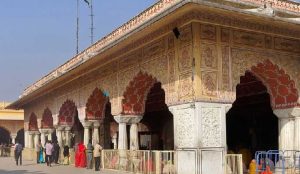
Image – Source
The aarti schedule at Govind Dev Ji Mandir is a highlight of the temple’s daily rituals and profoundly enhances the spiritual experience for devotees.
Aartis are performed seven times a day, each offering devotees a unique opportunity to connect with the divine. These ceremonies involve chanting, the rhythmic ringing of bells, and the lighting of lamps, creating an atmosphere filled with devotion and serenity.
Each aarti has its own significance, starting with the Mangla Aarti early in the morning, which signifies the awakening of Lord Govind Dev Ji.
The Dhoop Aarti and Shringar Aarti follow, focusing on offering incense and adorning the deity with beautiful garments and jewelry. The Rajbhog Aarti, performed just before noon, is a grand ceremony where food offerings (bhog) are made.
The evening rituals begin with the Gwal Aarti, symbolizing the Lord’s time with the cows. The Sandhya Aarti marks the transition from day to night, filling the temple with vibrant energy. Finally, the Shayan Aarti is performed at night, preparing the deity for rest.
Here’s a detailed table of the aarti schedule:
| Aarti | Time |
| Mangla Aarti | 4:30 AM to 5:00 AM |
| Dhoop Aarti | 7:45 AM to 9:00 AM |
| Shringar Aarti | 10:15 AM to 11:00 AM |
| Rajbhog Aarti | 11:30 AM to 12:00 PM |
| Gwal Aarti | 5:00 PM to 6:00 PM |
| Sandhya Aarti | 6:30 PM to 7:45 PM |
| Shayan Aarti | 8:15 PM to 8:45 PM |
The rhythmic flow of these rituals allows devotees to experience peace and spiritual elevation throughout the day. Participating in or witnessing these aartis is a deeply moving experience, as it strengthens the connection between the devotee and the divine.
For visitors, attending at least one aarti, especially the Mangla Aarti or Sandhya Aarti, is highly recommended to fully appreciate the temple’s spiritual essence.
What Are the Key Features of Govind Dev Ji Mandir?
Govind Dev Ji Mandir is renowned not only for its spiritual significance but also for its architectural beauty and unique features that captivate devotees and visitors alike. Situated within the City Palace complex, the temple seamlessly blends spirituality with cultural and historical grandeur.
1. Architectural Design
The temple’s structure reflects a mix of Rajasthani, Mughal, and classical Indian architectural styles. Built with red sandstone and marble, its intricate carvings and gold-adorned ceilings add a touch of royalty.
The temple is designed in such a way that the Chandra Mahal, the Maharaja’s residence, offers a clear view of the deity, symbolizing the central role of Lord Krishna in the life of Jaipur’s rulers.
2. Idol of Govind Dev Ji
The idol enshrined in the temple is considered one of the most sacred and lifelike representations of Lord Krishna. It is believed that the deity’s image closely resembles Krishna’s actual form during his earthly incarnation. This divine connection draws devotees from all corners of the world.
3. Sacred Artifacts and Décor
The interiors of the temple are adorned with European chandeliers, intricate paintings, and floral decorations, creating a serene yet majestic ambiance. The silver and gold ceremonial items, including lamps and utensils used during aartis, enhance the temple’s opulence.
4. Lush Gardens and Surroundings
The temple is surrounded by beautiful gardens, including the Talkatora Garden, which provides a tranquil space for meditation and relaxation. These lush green surroundings further amplify the spiritual and aesthetic appeal of the temple.
5. Cultural Significance
The temple serves as a hub for various religious and cultural activities, including bhajans, satsangs, and festivals like Janmashtami and Holi. These events transform the temple into a vibrant and spiritually charged space, attracting thousands of devotees.
6. Spiritual Atmosphere
The temple’s atmosphere is infused with devotional energy. The rhythmic chanting of mantras, the soothing sound of temple bells, and the fragrance of incense sticks create a serene environment that uplifts the spirit of every visitor.
Govind Dev Ji Mandir is more than just a place of worship; it is a symbol of Jaipur’s rich cultural heritage and a beacon of devotion that continues to inspire and attract people from all walks of life.
How Can Devotees Plan Their Visit to Govind Dev Ji Mandir?
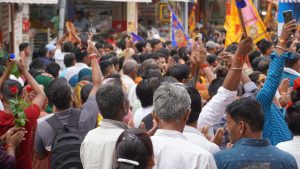
Planning a visit to Govind Dev Ji Mandir requires attention to key details to ensure a spiritually fulfilling and hassle-free experience. Here’s everything devotees need to know:
1. Best Time to Visit
The temple is open throughout the year, but the best time to visit is during the early hours for the Mangla Aarti, which starts at 4:30 AM in summer and 5:00 AM in winter. The temple is especially vibrant during festivals like Janmashtami and Holi, offering a chance to witness grand celebrations.
2. Darshan Guidelines
- Devotees should arrive early to avoid long queues, particularly during peak hours or festivals.
- Aarti schedules are fixed, so it’s advisable to plan your visit around these timings to experience the rituals.
- Modest or traditional attire is recommended to show respect for the temple’s sanctity.
3. Things to Bring
- Comfortable footwear, as you may need to walk within the City Palace complex.
- A water bottle, especially during summer months.
- Prayer items like flowers or incense sticks, which can be purchased near the temple.
4. Accessibility
The temple is easily accessible via road, rail, and air:
- By Air: Jaipur Airport is about 12 km from the temple.
- By Rail: Jaipur Railway Station is located 5.5 km away.
- By Road: Local transport such as auto-rickshaws, cycle rickshaws, and buses are available. Parking facilities are also nearby.
5. Special Tips for First-Time Visitors
- Photography and videography may be restricted during aarti, so confirm the temple’s rules beforehand.
- Avoid bringing restricted items like lighters, sharp objects, or alcohol.
- Allocate at least 1-2 hours to fully experience the temple and its surroundings.
6. Nearby Attractions
While visiting Govind Dev Ji Mandir, devotees can explore other nearby attractions such as:
- City Palace: A magnificent palace showcasing Jaipur’s royal heritage.
- Hawa Mahal: The iconic “Palace of Winds.”
- Jantar Mantar: A UNESCO World Heritage site featuring astronomical instruments.
- Amer Fort: A stunning fort with intricate architecture and rich history.
7. Festival Visit Planning
During major festivals, the temple attracts thousands of devotees. It’s best to plan your visit early in the day to avoid crowds. Special darshan arrangements may be available, but these typically involve longer waiting times.
With proper planning, a visit to Govind Dev Ji Mandir promises a spiritually enriching and culturally immersive experience that will leave devotees feeling blessed and uplifted.
Are There Any Festivals or Special Events Celebrated at the Mandir?
Govind Dev Ji Mandir is a hub of vibrant and biggest festivities and religious ceremonies, making it a spiritual and cultural hotspot in Jaipur. The temple celebrates several festivals and special events throughout the year, drawing devotees from across the country.
These occasions not only honor Lord Krishna but also offer a mesmerizing experience of Rajasthan’s rich heritage and devotion.
Major Festivals Celebrated
1. Janmashtami
- Celebrating the birth of Lord Krishna, Janmashtami is the most significant festival at Govind Dev Ji Mandir.
- The temple is beautifully decorated with flowers and lights. Thousands of devotees gather to sing bhajans and perform rituals.
- The midnight aarti marks the moment of Krishna’s birth, creating a divine atmosphere.
2. Holi
- The festival of colors is celebrated with great zeal. Devotees play Holi with flower petals and natural colors.
- Special bhajans and dances depicting the playful nature of Lord Krishna make the occasion lively.
3. Govardhan Puja
- Celebrated a day after Diwali, this festival commemorates Krishna’s lifting of the Govardhan Hill to protect his devotees.
- A grand Annakut (offering of various food items) is prepared and offered to the deity.
4. Radhashtami
- The birth anniversary of Radha Rani is celebrated with special rituals and devotional songs.
- The temple is adorned with fragrant flowers, and the deities are dressed in exquisite attire.
Special Events and Rituals
1. Jhulan Yatra (Swing Festival)
- Held during the monsoon season, this festival celebrates Krishna and Radha’s love.
- The deity is placed on an intricately designed swing, and devotees sing traditional songs while participating in the ceremony.
2. Gita Jayanti
- This event commemorates the day Lord Krishna delivered the Bhagavad Gita to Arjuna.
- Discourses and readings of the Gita are held in the temple.
3. Chappan Bhog
- A grand offering of 56 different food items is made to the deity, symbolizing Krishna’s love for food.
- Devotees flock to the temple to receive the blessed prasad.
Special Arrangements During Festivals
- The temple organizes processions, where the idols of Krishna and Radha are carried in beautifully decorated chariots.
- Bhajan sessions and cultural programs, including traditional Rajasthani folk dances, are arranged during these festivals.
- Additional darshan timings and extended aarti schedules are introduced to accommodate the large number of devotees.
These festivals and special events bring the temple to life with devotion, music, and joy, offering devotees a memorable and spiritually uplifting experience.
What Are the Nearby Attractions to Explore in Jaipur?
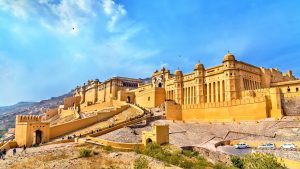
A visit to Govind Dev Ji Mandir offers an excellent opportunity to explore Jaipur’s rich cultural and historical landmarks. Here are some nearby attractions:
- City Palace: Located within the same complex as the temple, the City Palace showcases Jaipur’s royal heritage with its intricate architecture and stunning courtyards.
- Hawa Mahal: Known as the “Palace of Winds,” this iconic structure features hundreds of small windows designed for royal women to observe city life.
- Jantar Mantar: A UNESCO World Heritage site, this astronomical observatory houses ancient instruments that demonstrate the scientific brilliance of its era.
- Amer Fort: Situated on a hill, this grand fort features artistic architecture, stunning courtyards, and scenic views of Maota Lake.
- Jal Mahal: A beautiful palace floating in the middle of Man Sagar Lake, Jal Mahal is perfect for photography and serene strolls.
Exploring these attractions alongside the temple visit ensures a well-rounded experience of Jaipur’s vibrant culture and history.
Where to Stay in Jaipur?
Jaipur offers a wide range of accommodation options to suit every traveler’s budget and preferences. Visitors to Govind Dev Ji Mandir can choose from the following popular places to stay:
- Panchayati Dharamshala: An affordable and clean option, ideal for families and groups seeking a spiritual environment.
- ISKCON Guest House: Located near the temple, this guest house offers basic amenities and a peaceful stay.
- Janupyogi Bhawan: A budget-friendly option with simple rooms and a focus on providing a comfortable stay for pilgrims.
- Hotel Lords Plaza: A mid-range hotel offering modern amenities, including Wi-Fi and in-house dining, ideal for families and business travelers.
For a more luxurious experience, Jaipur has several high-end hotels and heritage properties, such as the Taj Rambagh Palace and Alsisar Haveli, which provide a royal ambiance.
Whether you’re visiting for pilgrimage or sightseeing, Jaipur’s accommodations ensure a comfortable and memorable stay.
Conclusion
Govind Dev Ji Mandir stands as a spiritual beacon in Jaipur, attracting thousands of devotees and tourists each year. Its rich history, stunning architecture, and vibrant aarti ceremonies create an atmosphere of deep devotion and cultural significance.
Whether attending the Mangla Aarti at dawn or exploring the temple’s unique connection to Jaipur’s royal heritage, every visitor experiences a profound sense of peace and spirituality.
Coupled with nearby attractions like the City Palace and Hawa Mahal, a visit to this sacred temple offers a complete cultural journey. Truly, Govind Dev Ji Mandir is a place where faith, history, and tradition beautifully converge, leaving an everlasting impression on the hearts of its visitors.
FAQs About Govind Dev Ji Mandir Timing
Is there an entry fee for Govind Dev Ji Mandir?
No, the temple has no entry fee, and visitors can enjoy darshan free of cost.
What is the best time to visit the temple?
The best time is early morning for the Mangla Aarti (4:30 AM in summer, 5:00 AM in winter) to experience the divine atmosphere.
Are photography and videography allowed inside?
Photography and videography are generally prohibited, especially during aarti times, to maintain the sanctity of the rituals.
Is there a dress code for visitors?
Yes, traditional or modest attire is recommended to show respect for the temple’s religious environment.
Can prasad be purchased at the temple?
Yes, prasad is available for purchase within the temple complex.
Are parking facilities available near the temple?
Yes, ample parking is available near the temple for cars and two-wheelers.
What festivals are best to visit the temple?
Festivals like Janmashtami, Holi, and Govardhan Puja are the best times for a vibrant experience.
Disclaimer
India Travel App does not own the above images used in this blog; the copyrights of those blogs belong to the respective owners only.




